Murder on Music Row: Could Kevin Hughes' death been mistaken identity over a spurned lover?
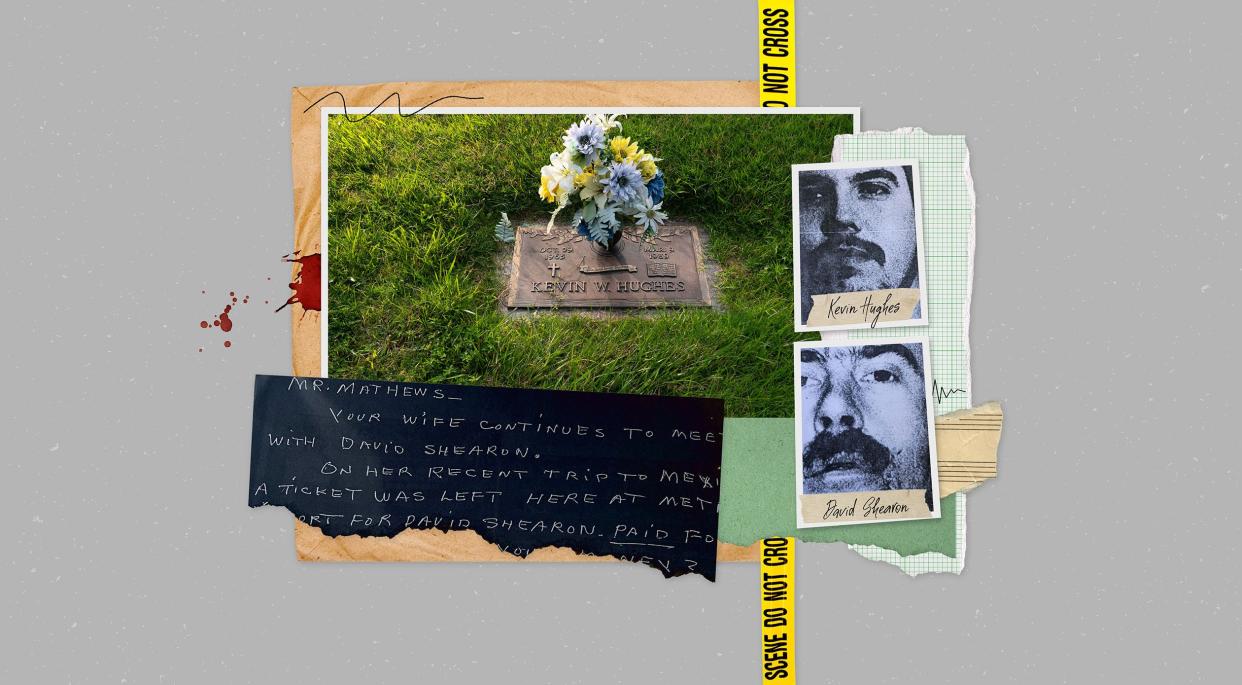
This is the fifth in an eight-part series exploring the 1989 murder of Kevin Hughes, a country music chart director who knew too much.
He threw the hotel key out the window.
David Shearon had been seeing a woman on the sly, and that key — from Room No. 1812 at the Nashville Airport Residence Inn — was a memory of the last time he had seen her.
When he tossed it, Shearon had no idea it would become evidence in a murder case.
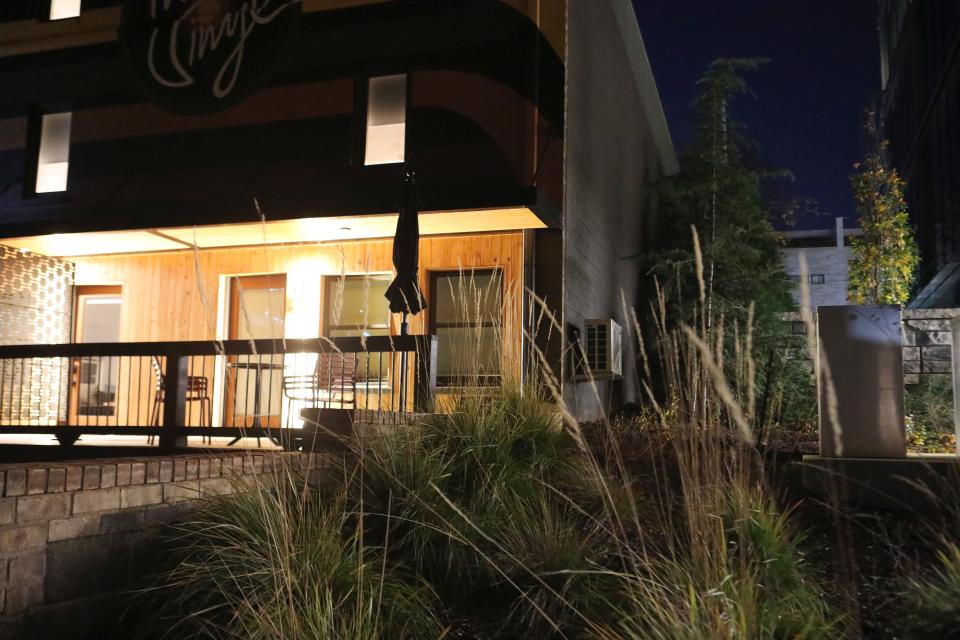
Shearon lived on Music Row, 1020 16th Ave. S, Apt. 4.
Shearon was separated from his wife, Patti, who, as you might have guessed, was not the woman in the hotel room.
On March 15, 1989, six days after Kevin Hughes was shot to death on Music Row, detectives Chuck Lewis and Gene Lonegan were at the scene of the murder when they noticed something shiny on the ground between buildings.
They found the hotel key.
Which, they thought, was the key to the whole thing.
With that key, Lewis got permission to run a simultaneous investigation into the murder of Kevin Hughes. This one didn’t involve music or charts or seedy promoters.
The theory Lewis pursued was more classic in its crime motivations. It involved lust, betrayal and revenge.
Could the Kevin Hughes homicide be a case of a jealous husband and mistaken identity?
Here’s the quick backstory (compiled from Lewis’ summary from Sept. 12, 1989):
In January 1989, a man named Ken Matthews got an anonymous phone call that his wife Sherry was having an affair. It was later determined the call had come from an elderly woman who lived across the street from the Matthewses.
The neighbor also wrote him two letters tattling on his wife.
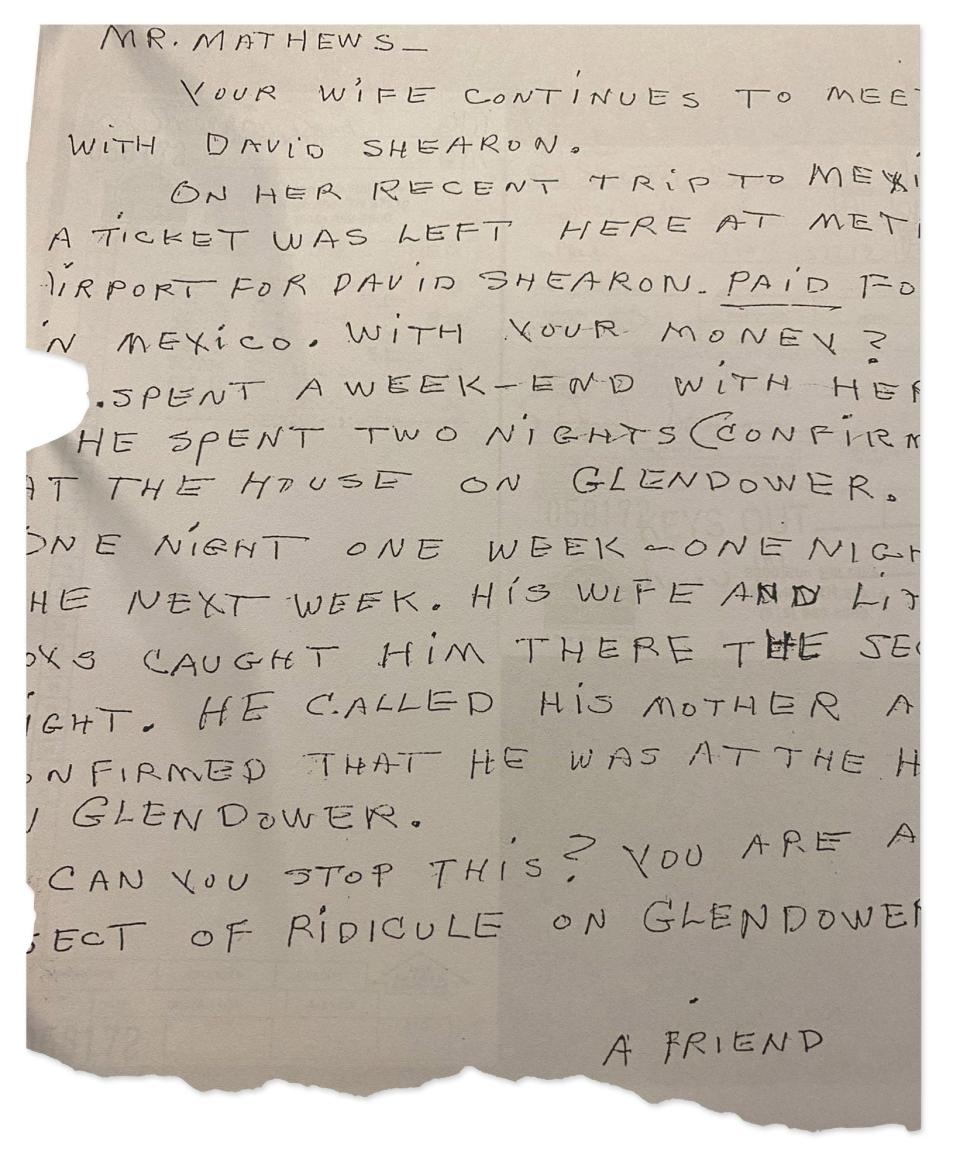
On Jan. 15, Matthews went to Shearon’s apartment on Music Row and told David, “Listen here S.O.B., you don’t know me or anything about my temper, and if you are messing around with Sherry, you had better leave her alone.”
Secretly, after that threat, Ken Matthews called Patti Shearon (David’s wife) to talk about hiring a private investigator to follow their spouses. As he talked, Patti Shearon said, she could hear Matthews spinning and snapping the cylinder of a pistol.
On Feb. 19, Ken Matthews followed Sherry as she drove David Shearon in her car. Unaware they were being watched, Sherry Matthews dropped off her paramour in an alley between 17th and 18th Ave. S. He got out of the car and walked to his apartment.
Shearon’s route passed next to Evergreen Records.
Sherry Matthews would later tell Lewis that was their regular drop-off spot and his regular route back to his apartment.
On Feb. 26, Sherry and David slipped off to Captain D’s for a clandestine dinner. They were followed by Ken Matthews, who confronted them in the parking lot.
Sherry told police she thought he had a gun in his pocket. She said he approached the car and said, “I got you now, you S.O.B. Get out. I’m going to kill you.”
David Shearon didn’t get out of the car.
Sherry, who was driving, sped out of the parking lot.
On March 9, the night of the Hughes homicide, Sherry and David had another clandestine dinner at Kroger’s Super Store on Nolensville Pike. During that clandestine meeting, police knew Matthews was in the neighborhood because he made a credit card purchase at a store about a quarter-mile away from Kroger.
When the lovers finished, they left in separate cars at 8 p.m.
David Shearon was driving a rented, blue Dodge Shadow.
Here’s where the Lewis narrative gets a little squishy. In order to believe Matthews is Hughes’ killer, you would also have to believe he lost track of Shearon at that point.
According to Lewis, Matthews picked up his surveillance again two hours later, around 10 p.m. at Captain D’s on West End. But at that point, he began following the wrong guy (Hughes) and also mistook the identity of another guy (Sadler).
Between 9 p.m. and 10 p.m. on March 9, Kevin Hughes and Sammy Sadler went to dinner at Captain D’s, the same place Sherry and David had eaten two weeks before.
Lewis’ report said he and other officers believed Matthews was, coincidentally, waiting in the Captain D’s parking lot. When he saw Hughes and Sadler going inside, he mistakenly believed David Shearon and his nephew Joe Shearon were having dinner, Lewis reported.
Hughes and Sadler left the restaurant at 10 p.m. and got into Hughes’ blue Pontiac Sunbird, which looks similar to a rented, blue Dodge Shadow.
If Matthews was the killer, he must have had the gun, ski mask and blue hat ready in the car.
Lewis said Matthews followed Hughes and Sadler to Evergreen Records. He watched them park and go inside. If he thought he was following David Shearon, why did Matthews think Shearon was going into the record studio instead of his apartment directly across the street?
Wouldn’t that have been a clue he was following the wrong guy?
Lewis believed Matthews hid between the apartment buildings, just below Shearon’s window.
Lewis’ summary report begins this way: “Kenneth D. Matthews is the primary suspect in the murder of Kevin Wayne Hughes …”
Another line in that report: “Ms. Matthews states that she thinks her husband Ken killed Kevin Hughes by mistake while trying to kill David Shearon.”
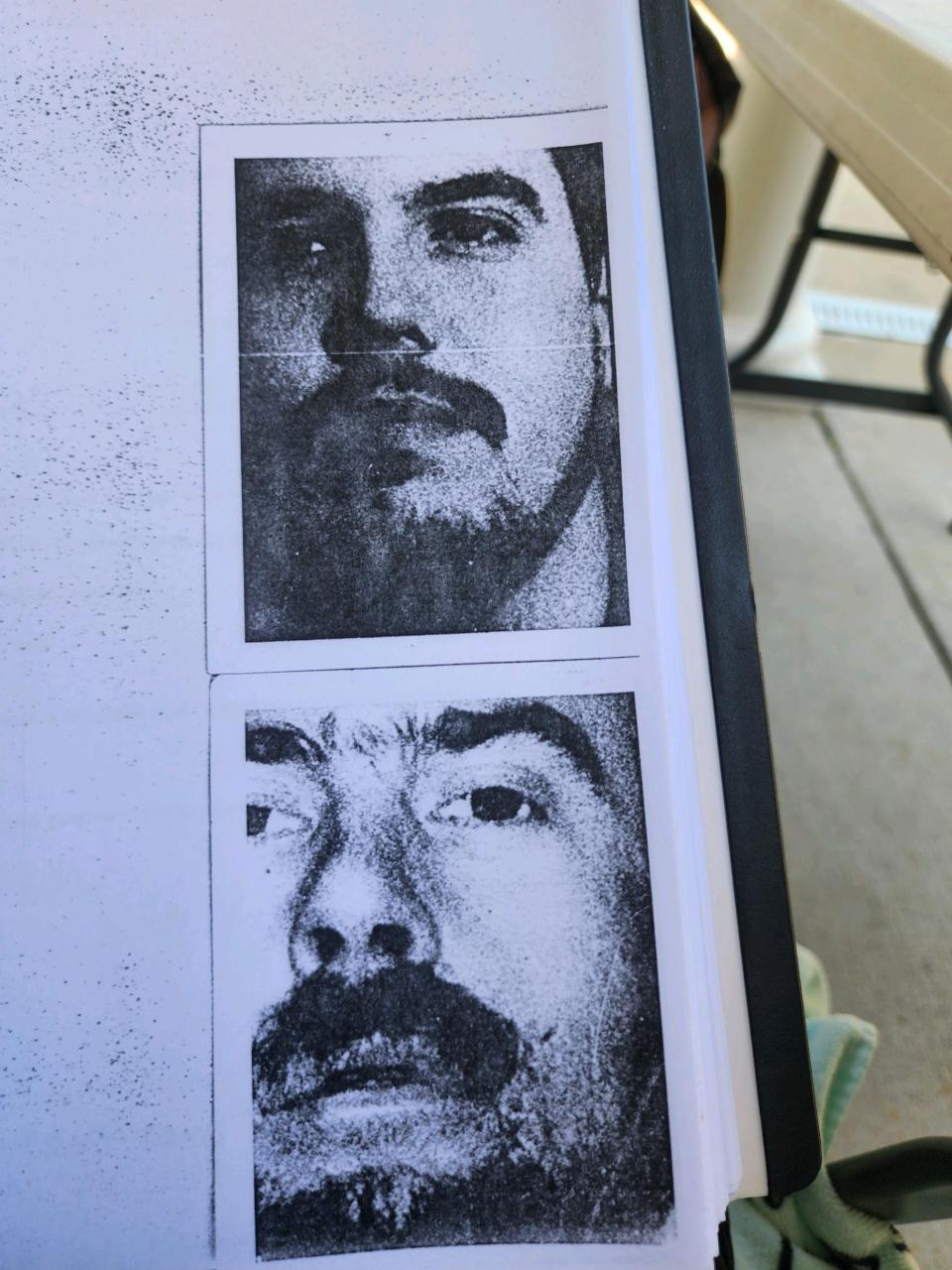
Matthews, who was interviewed by Lewis over the phone on March 30, 1989, agreed to come to the Nashville Criminal Justice Center for an interview.
On Aug. 18, Matthews denied killing Hughes. He passed a polygraph test.
“When Ken came in for the interview, he stated that he was just an old salesman that was having trouble with his wife,” Lewis wrote. “That he had washed the whole thing out of his memory.”
There’s more.
As Lewis looked into Matthews’ background, he found some red flags.
Matthews’ first wife, Norma Jean, had been found dead in their bed at age 41 in 1979. The coroner ruled she died of natural causes. The housekeeper who found the body said the last interaction between Matthews and his wife was when he gave her a cup of tea.
Matthews’ former business partner, Fred Jones, also died (“unexpectedly” Lewis wrote) at age 42 in 1981.
Lewis found that despite some strange occurrences around him, Matthews had no criminal record.
He was, by all accounts, a stalker even before that term described an illegal practice.
The Kevin Hughes police file includes several letters Matthews wrote to his wife.
“Sugar, you said to call if I needed you. But if I did that, you would not get any peace because I would be calling you 24 hours a day. I love you. Ken.”
“Darling, you are just the same beautiful, sexy, appealing, sweety pie that I married 9 years ago. I beg to remain your loving husband. Ken.”
After the murder, the Sherry/David affair continued. And Ken Matthews continued paying very close attention to his wife’s movements.
Lewis, the detective, wrapped up his investigation in six months. He produced a document with 100 bullet points explaining how and why Ken Matthews killed Kevin Hughes (plus a 23-point supplemental report on how Ken Matthews killed his first wife, Norma Jean).
Lewis didn’t have any direct evidence — no gun, no eyewitnesses, no confession. His case was all circumstantial.
The Lewis narrative stalled right there.
This murder had to be about the music, right?

This investigation drew the ire of lead detective Bill Pridemore.
“I didn’t even want to listen to that bullshit,” Pridemore said.
He was sure there was one word at the heart of the Kevin Hughes homicide.
Music.
By the end of the first year, Pridemore had one primary area of inquiry. He was looking at the confluence of three men in Hughes’ life – Sadler, Richard “Tony” D’Antonio and Chuck Dixon.
Pridemore had been told that Dixon and D’Antonio were a corrupt tandem, working together to rip off young singers.
Pridemore believed Sadler worked with Dixon to get his records on the corrupt Cash Box chart.
Hughes, Pridemore learned, was close with all of them. D’Antonio had hired him at Cash Box. Sadler had become Hughes’ friend in recent months.
And two of Hughes’ friends — Leslie Levin and Kent Crawford — both knew Hughes when he was at Belmont College and said Hughes had accepted a couple of small bribes from Dixon.
At the Country Radio Seminar, held a week before Hughes was shot to death, Hughes created a scene when he openly refused to take money from Dixon — then changed his mind and took the money. The moment was witnessed by dozens of people.
That public gesture may have signaled to Dixon that Hughes was tired of the casual corruption.
Pridemore’s interview with Crawford had helped with the timeline of Hughes’ last night.
Crawford had talked with Hughes in the late afternoon of March 9, 1989. Hughes told him he was going to the movies (“Bill and Ted’s Excellent Adventure”) with a friend named Sharon Pennington at 5 p.m. Then he was going riding around in a car with a friend.
That second tiny detail, the “riding around with a friend” part, is very strange. Sadler has always said he never made early plans to meet Hughes. In media interviews over the last three decades, he said he didn’t decide to call Hughes until much later, after he and his wife argued, after 7 p.m.
Sadler has always said the visit with Hughes was unplanned.
Crawford, however, would not have been able to testify even if his recollections had been necessary.
Eleven years after his college friend Hughes was gunned down, Crawford was shot to death by his wife while he slept. The shooting happened in Indiana, four days before the anniversary of Hughes’ death.
Tracy Crawford, who was later determined to be mentally ill, was sentenced to 65 years in prison. The shooting was unrelated to what happened in Nashville.
Two Belmont friends were killed by point-blank shots to the head.
Small world.
TV shows bring new attention to murder on Music Row

Pridemore and Postiglione chased several leads.
They tried to find the manufacturer of the blue hat that was worn by the killer and found at the scene. They weren’t having any luck.
They quickly found that the black hair plucked from the inside of the hat belonged, not to the killer, but to a cat.
They tried to match the bullets with other murders in Nashville.
None of the Hughes bullets matched.
Ten months after the homicide, the Murder Squad began looking for clues in a very public place.
Television.
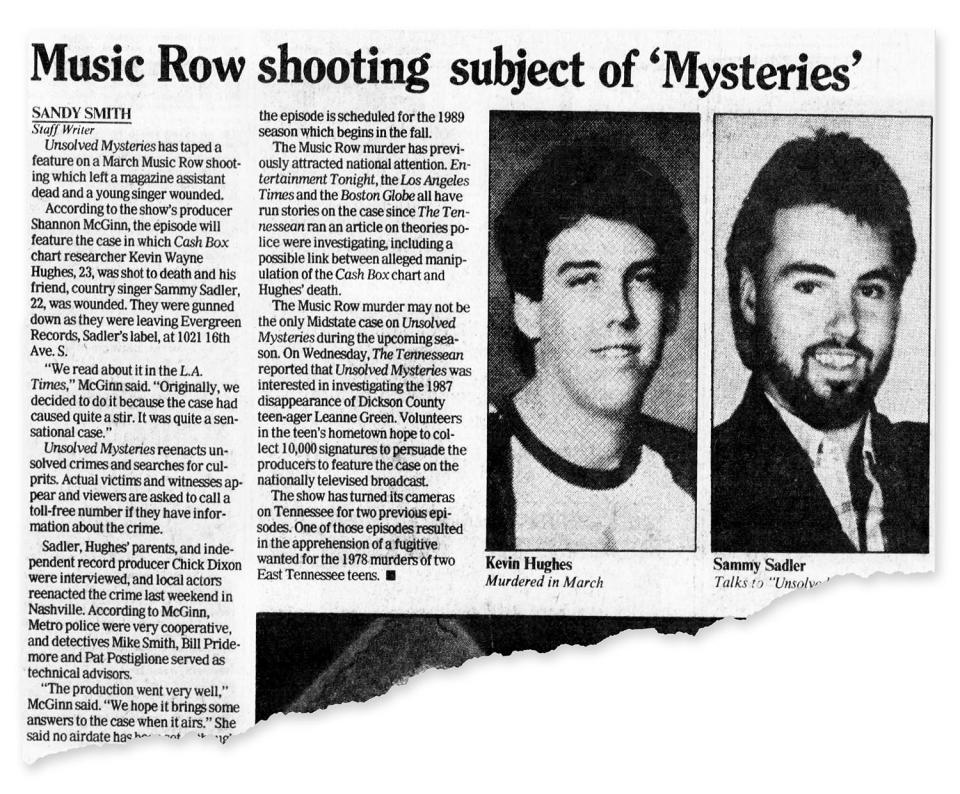
On Jan. 17, 1990, the crime show “Unsolved Mysteries” focused on Kevin Hughes.
The show, hosted by actor Robert Stack, was in its second year of production. The Kevin Hughes story was the 44th of 233 episodes produced over 14 years. The Hughes case was called simply “Unexplained Death.”
A few weeks later, a similar show — Crime Stoppers — also featured the Kevin Hughes homicide. (Crime Stoppers caught the attention of a man in Georgia, who, years later, would become a key to the investigation.)
The first person interviewed on the “Unsolved Mysteries” show was Sharon Pennington, who had gone to the movies with Hughes on the night he died. She worked at an independent record label.
“Nashville is like dreamland,” Pennington said. “People have these big fantasies. And everyday, people come here to make their fantasy or their dream come true. A lot of those people sacrifice their whole life savings. They’ll spend their entire life savings, everything they’ve got, on that dream.”
Then, a few minutes into the show, Chuck Dixon appeared. He sat in a leather chair.
“In my career as a promoter, I’ve been through 12, 15 maybe more chart directors,” Dixon said. “He (Hughes) was probably, overall, not only the best, but the most fair.”
Pennington continued about Hughes: “He was real rare for any kind of business, not just the music business. He was just very kind and very religious and just a Christian all the way around. He was very honest and trustworthy and loyal. And he loved his job.”
Sammy Sadler was next up, saying the whole night was random. They didn’t know they were going to eat, and they didn’t know they were going to stop at Evergreen to make a phone call — until minutes before they did.
Pridemore wore a blue blazer and a loose tie. “We have no motive,” Pridemore said. “We have no suspect. We have no solid witnesses even though we have five people that witnessed this. We have none that can tell us what the suspect looked like.”
Host Robert Stack said there were rumors that Hughes was killed by a professional hit man because he refused to participate in a chart manipulation scheme.
Postiglione, looking dapper in a light blue suit and maroon tie with gold spots, said he wasn’t buying it.

“On the surface it looks like a pretty good theory,” Postiglione said. “That Kevin was in a position that he could take a No. 100 song, and make it a No. 5. Or the charts could be padded. And Kevin, if he was taking money from somebody, from a promoter or a singer … he could, in theory, push this person’s record up. But we found no evidence of that. He was not the kind of person to be involved in that.”
Pridemore: “His job wasn’t that important to be killed for.”
Then Dixon again: “It might be a person that didn’t understand, that maybe blamed Kevin for the failure … because he wrote a song and it didn’t become successful. And he needed somebody to blame. I could say that could be a theory. But that’s the only way that I would ever believe that it was music-related.”
The episode ended with Sadler saying he hopes the case gets solved.
The next day, Jan. 18, 1990, calls poured into the hotline the Metro Nashville Police set up.
Several of the calls named people who police had already cleared in the murder of Kevin Hughes.
Five of the calls said they knew the maker of the hat. None of them were correct.
And two of the calls said Hughes was killed because he wouldn’t alter the Cash Box music charts. Both calls named the same man as the killer.
The same man promoter Bill Wence had called and said, “We know you did it.”
Richard “Tony” D’Antonio.
This article originally appeared on Nashville Tennessean: Kevin Hughes death: Nashville police concoct alternate homicide theory

